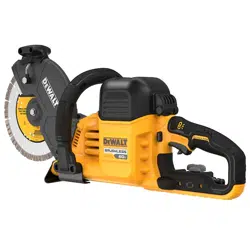Loading ...
Loading ...
Loading ...

ENGLISH
8
• Remove the cutting wheel after use. The cutting wheel
may suffer damage duringtransport.
• Never use a cutting wheel that is damaged, is untrue
orvibrates.
• Never use your cut‑off machine while standing on a
ladder orscaffolding.
• Never cut above your shoulderheight.
• Do not cut wood or any material from which the
cutting wheel is notrated.
• Use the wet cut method when using a diamond blade
whenever possible. The water can act as a lubricant and
reduce the risk reactiveforces.
• Use caution when reentering a cut. Do not push the
cutting wheel into the cut at an angle as this can increase
the risk onbinding.
• Always be alert of anything that could cause the
workpiece to close at the cut and pinch the cutting
wheel. Always support the workpiece in a manner that
results in the cut remaining open. Never make a cut that
could result in binding of the cuttingwheel.
WARNING: ALWAYS use safety glasses. Everyday
eyeglasses are NOT safety glasses. Also use face or
dust mask if cutting operation is dusty. ALWAYS WEAR
CERTIFIED SAFETYEQUIPMENT:
• ANSI Z87.1 eye protection (CAN/CSA Z94.3),
• ANSI S12.6 (S3.19) hearing protection,
• NIOSH/OSHA/MSHA respiratoryprotection.
WARNING: Some dust created by power sanding,
sawing, grinding, drilling, and other construction
activities contains chemicals known to the State
of California to cause cancer, birth defects or
other reproductive harm. Some examples of these
chemicalsare:
• lead from lead‑based paints,
• crystalline silica from bricks and cement and other
masonry products, and
• arsenic and chromium from
chemically‑treatedlumber.
Your risk from these exposures varies, depending on how
often you do this type of work. To reduce your exposure to
these chemicals: work in a well ventilated area, and work with
approved safety equipment, such as those dust masks that are
specially designed to filter out microscopicparticles.
• Avoid prolonged contact with dust from power
sanding, sawing, grinding, drilling, and other
construction activities. Wear protective clothing and
wash exposed areas with soap and water. Allowing
dust to get into your mouth, eyes, or lay on the skin may
promote absorption of harmfulchemicals.
WARNING: Use of this tool can generate and/or
disperse dust, which may cause serious and permanent
respiratory or other injury. Always use NIOSH/OSHA
approved respiratory protection appropriate for
the dust exposure. Direct particles away from face
andbody.
Additional Safety Information
• Use of accessories not specified in this manual is not
recommended and may be hazardous. Use of power
boosters that would cause the tool to be driven at speeds
greater than its rated speed constitutesmisuse.
• Do not use circular saw blades with this tool. Serious
injury mayresult.
• Avoid bouncing the wheel or giving it rough
treatment. If this occurs, stop the tool and inspect the
wheel for cracks orflaws.
• Direct sparks away from operator, bystanders or
flammable materials. Sparks may be produced while
using a cut‑off tool. Sparks may cause burns or startfires.
• Always use front handle. Make sure the front handle
is securely tightened before use. The front handle
should always be used to maintain control of the tool at
alltimes.
• Never cut into area that may contain electrical wiring
or piping. Serious injury mayresult.
• Clean out your tool often, especially after heavy use.
Dust and grit containing metal particles often accumulate
on interior surfaces and could create an electric
shockhazard.
• Do not operate this tool for long periods of time.
Vibration caused by tool action may be harmful
to your hands and arms. Use gloves to provide extra
cushion and limit exposure by taking frequent restperiods.
• Never use the weight of the tool to stop
bladerotation.
• Never leave your cut‑off machine unattended if it is in
operating mode. When your cut‑off machine is not in use,
remove the battery pack, make sure the trigger switch is in
the OFF position and lock‑off button isengaged.
• Always wear sturdy boots with non‑slip soles and
heavy‑duty work gloves when operating your cut‑off
machine. Heavy‑duty gloves improve your grip and
protect yourhands.
• Always use NIOSH/OSHA approved respiratory
protection when wet cutting below the recommended
flowrate.
• Consult and follow any federal, state or local laws or
regulations with respect to dry and wetcutting.
• Never touch the rotating wheel with any part of
yourbody.
• When transporting the machine always make sure
the lock‑off button is in the lockedposition.
i ) Support panels or any oversized workpiece to
minimize the risk of wheel pinching and kickback.
Large workpieces tend to sag under their own
weight. Supports must be placed under the workpiece
near the line of cut and near the edge of the workpiece
on both sides of thewheel.
j ) Use extra caution when making a “pocket cut”
into existing walls or other blind areas. The
protruding wheel may cut gas or water pipes, electrical
wiring or objects that can causekickback.
Loading ...
Loading ...
Loading ...
